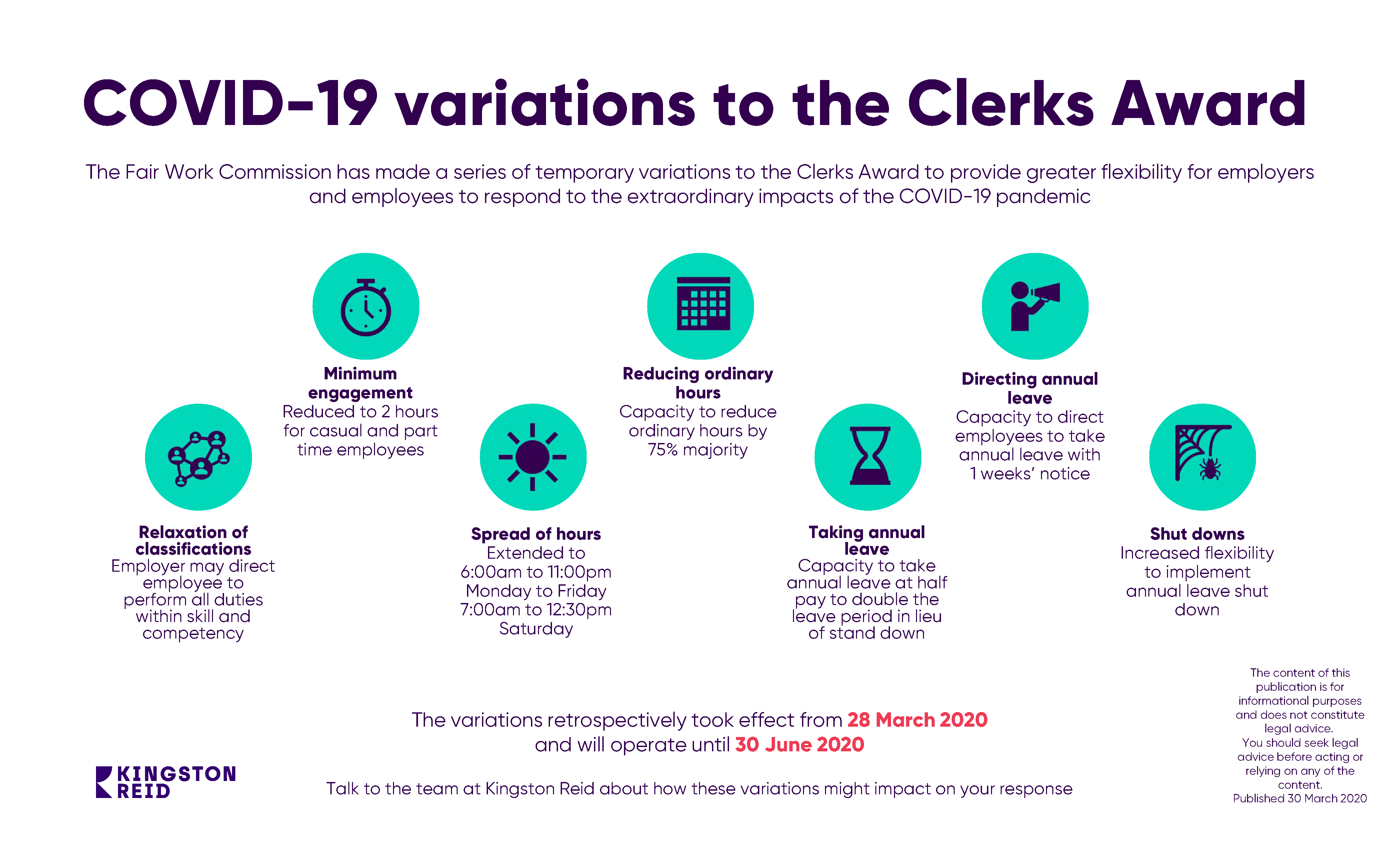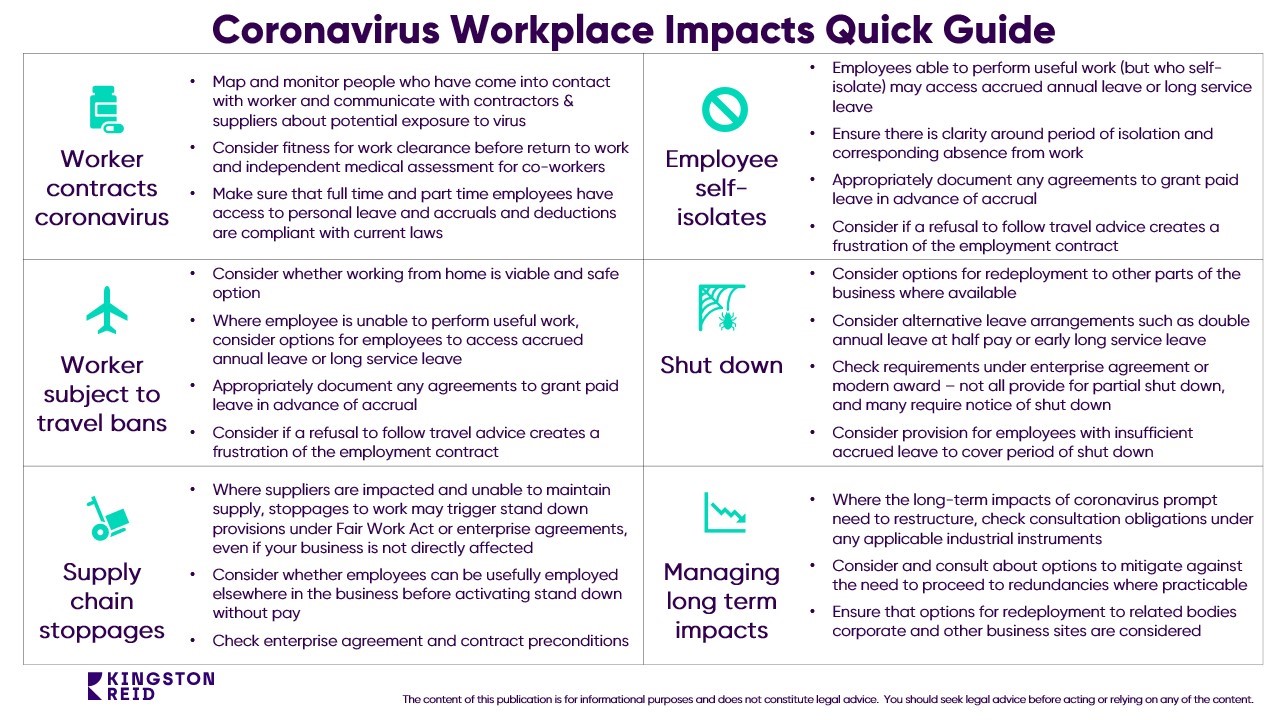April 8, 2020
A Bill proposing amendments to the Fair Work Act 2009 (FW Act) has been introduced into Parliament today, 8 April 2020.
The amendments propose temporary changes to the FW Act to assist employers who qualify for the JobKeeper scheme to deal with the economic impact of COVID-19.
There are three categories of amendments.
- JobKeeper-enabling stand down
- Alteration to duties and location of work
- Agreement to change days of work or take annual leave
JobKeeper-enabling stand down
The JobKeeper enabling stand down provisions allows an employer to alter an employees’ hours of work by directing an employee to:
- not work on a day the employee would usually work
- work for a lesser period than they would ordinarily work on a particular day
- work a reduced number of hours (including no hours).
Any such direction may only occur where it is:
- safe; and
- the employee cannot be usefully employed at their normal days or hours because of changes attributable to COVID-19 pandemic; or government initiatives to slow the spread of COVID-19.
The direction must be in writing and requires the employer to:
- give the employee written notice of the intention to give the direction; and
- provide the notice at least 3 days (or less, by agreement) before the direction is given; and
- consult with the employee (or a representative of the employee) and keep written records of the consultation
The direction will cease to have effect no later than 28 September 2020.
This amendment will not change the hourly rate of an employee subject to a direction.
The JobKeeper enabling stand down direction does not apply to the employee during a period when the employee:
- is taking paid or unpaid leave that is authorised by the employer; or
- is otherwise authorised to be absent.
Alteration to duties and location of work
This amendment allows an employer to alter the duties performed by an employee or the location of the employee’s work.
Duties
An employee may be directed to perform alternative duties if the duties are:
- safe;
- reasonable in all the circumstances;
- within the skill and competency of the employee; and
- reasonably within the scope of the business in question
The employee must not earn less than:
- what they are currently earning; or
- the base rate of pay applicable to the duties the employee is performing as set out in an industrial instrument,
whichever is greater.
Location
An employee may be directed to perform duties at a different location where:
- the place is suitable for their duties
- the place does not require unreasonable travel
- the location is safe
A direction to alter duties or location is only reasonable to the extent that it is necessary to ensure the employee’s continuing employment.
Agreement to change days of work or take annual leave
Changing days of work
An employer who qualifies for JobKeeper in relation to an employee and that employee to agree to the employee performing work on different days or at different times during a period.
The agreement is authorised if the employer qualifies for the JobKeeper scheme in relation to that employee; and if
- the performance of the duties on different days or at different times is safe, having regard to the nature and spread of Coronavirus and reasonably within the scope of the employer’s operations; and
- the agreement does not reduce the employee’s number of hours of work compared with the employee’s ordinary hours of work (noting the ability to reduce hours under section 789GDC of the proposed Bill).
Employees must consider and must not unreasonably refuse the employer’s request for agreement to these arrangements. In the absence of an employee’s agreement the matter could be settled by the FWC.
The circumstances of the workplace will inform what is reasonable.
Taking annual leave
An employee can consider their employer’s request for them to take paid annual leave and can agree to take paid annual leave at half pay.
If an employer qualifies for the JobKeeper scheme in relation to an employee, the employee must consider and must not unreasonably refuse the employer’s request to take annual leave, provided that the leave arrangement will not result in a leave balance of less than 2 weeks. In the absence of an employee’s agreement the matter could be settled by the FWC.
Employees and employers can also agree to the employee taking twice as much annual leave at half the employee’s rate of pay for a period.
An employee or employer may seek review of a decision made under the amendment by the Fair Work Commission (FWC). The FWC may review through the usual means including conciliation or arbitration.
Any contravention of the amendments may result in penalties.
For additional information and resources relating to the workplace impacts of COVID-19, visit our COVID-19 Resources page.
Christa Lenard
Partner
+61 2 9169 8404
[email protected]
Sophie Baartz
Associate
+61 2 9169 8416
[email protected]
Xanthe Shaw
Lawyer
+61 8 6381 7055
[email protected]


